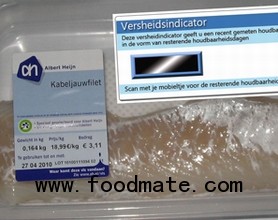 le Heising from Wageningen University in The Netherlands is developing a new packaging innovation for seafood that lets consumers know how fresh the product is without opening the package.
le Heising from Wageningen University in The Netherlands is developing a new packaging innovation for seafood that lets consumers know how fresh the product is without opening the package.The innovative packaging features a built-in sensor, or chip that communicates the freshness of the fish via smartphone before purchase, helping consumers avoid rancid or ‘off’ products.
As the fish decays inside the packaging, various substances are released which are then dissolved into water and then into the sensor.
Throughout her research, Heising investigated the practicalities of using a number of different sensors including those that measure acidity, ammonia and conductivity.
She found that the ammonia sensor was unreliable as the substance was only released once the fish was essentially bad, and the acidity sensor was deemed inaccurate as temperature appeared to interfere with the readings.
Conductivity sensors however have proven to be more reliable. As substances are released from the fish, water appears to conduct electricity more easily enabling the sensor to assess how fresh the fish at differing temperatures.
'We can see an effect very rapidly and that is just what we need. It seems we’ve found a good method. To confirm that, we’d also like to know in more detail which substances cause that effect. That’s what we’re investigating at the moment,’ she said.
Heising says that the senor chip will most likely be contained within a small piece of gel and packed in with the fish and read with RFID (radio-frequency identification). Consumers will be able to read the chip information via their smartphones.





